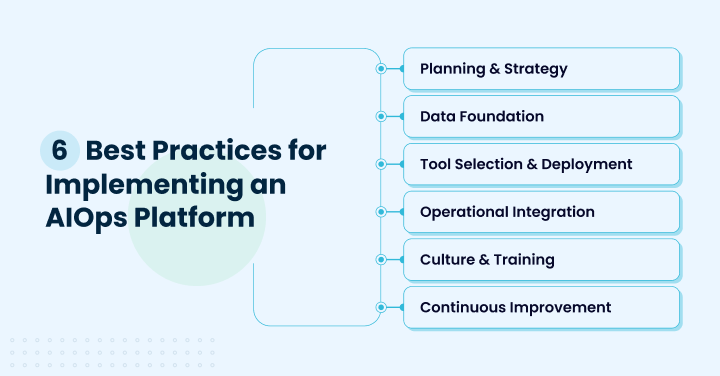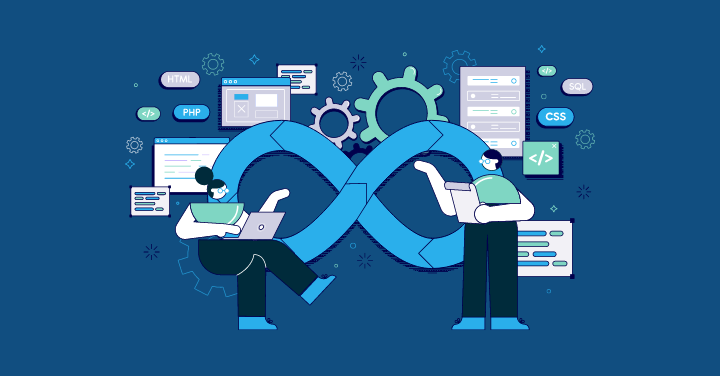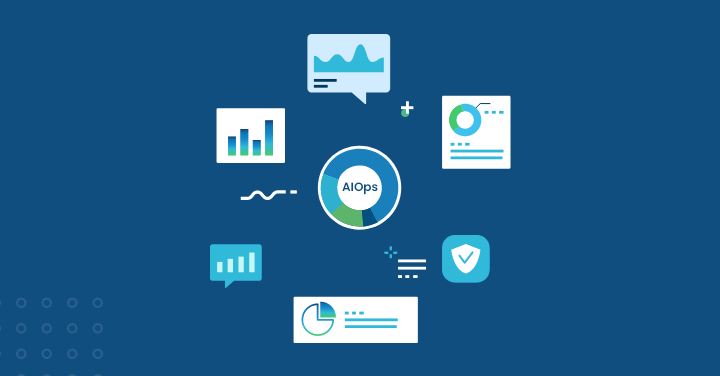Earlier when cloud computing and digital technologies were not a part of our daily lives, businesses used traditional IT on-premises systems to manage all the performance data.
But with cloud computing and digital transformation, businesses started to expand and so did their data. Some businesses even established their branches in other parts of the country, making it highly complex for IT operations teams and professionals to manage such big data.
This is when the AIOps tools were incorporated into the modern IT environment to streamline all the processes and ease the complexity brought on by cloud environments.
Artificial intelligence for IT operations (AIOps) refers to the manner or technique in which an IT team manages data and information from an application environment. These platforms basically use big data machine learning methods and advanced artificial intelligence technologies to ensure effective IT operations functions and zero downtime.
By implementing AIOps tools, businesses can analyze historical data as well as current data files in large volumes. Further, it provides insightful reports that help organizations resolve performance issues faster as well as automate repetitive tasks.
However, it also comes with multiple challenges such as talent gap, data quality, etc. Let us discuss each of these challenges in detail as well as pen down best practices for Implementing an AIOps Platform.
Common Challenges of AIOps and How to Overcome Them
Several businesses have started embracing AIOps in an effort to improve IT operations. However, they often face challenges while using this system that could prevent an efficient and effective deployment.
Hence, the first step to overcome them and realize the full potential of AIOps is to comprehend these challenges.
1. Data Quality
The whole task of providing in-depth insights using AI and ML technologies completely depends on the quality of data collected from different sources. If due for any reason, the AIOps tool receives inaccurate or incomplete data, chances are high that it will result in poor analysis, wrong predictions, and incorrect business decisions.
Hence, it is essential to implement data governance practices to overcome this challenge. Data governance tools can be helpful in ensuring data integrity, consistency, and accuracy, thereby enhancing the reliability of the insights derived from AI and ML technologies. Also, make sure to run regular data quality audits to identify any incorrect or inaccurate information beforehand. Additionally, you can incorporate data cleansing techniques to check on the quality of collected data.
2. Talent Gap
Another challenge that most AIOps users face is the need for professionals with IT operational knowledge and data science skills. Finding or hiring specialists with similar expertise in itself is a challenge.
The only way to overcome this situation is to either train existing IT staff with these skills or run workshops to fill the talent gap.
3. Security Concerns
Sensitive data handling on the AIOps platform poses security issues. The security and integrity of the data may be jeopardized by data breaches or illegal access.
Hence, the best solution is to incorporate robust security protocols and measures to reduce risk and ensure data safety. You can even run security audits to identify bottlenecks and loopholes in the system.
Furthermore, maintaining adherence to industry rules and guidelines, such as GDPR or HIPAA, strengthens data security features in the AIOps platform.
Best Practices for Implementing an AIOps Platform
In order to ensure complete success within your organization, careful planning and execution of the AIOps platform is crucial. Here are a few practices for the successful implementation of an AIOps platform.
1. Planning and Strategy
- Define Your Goals: Make sure to be specific about your actual objective behind implementing an AIOps tool, i.e., to reduce downtime by identifying potential problems at an early stage, improve MTTR using ML techniques, or reduce alert fatigue for your engineers. By being specific about your objectives, you can better measure them and evaluate their performance over a period.
- Choose the Initial Scope: Instead of covering all the areas of an IT infrastructure at once, try to cover each section one at a time. Run analysis and figure out a section where with utmost attention and AIOps techniques, you can deliver the most immediate impact. It can be the interconnected systems and their dependencies or a specific domain in your infrastructure that often notifies you about errors and potential issues. By focusing on the targeted areas, you can troubleshoot issues and ensure efficiency in your business operations.
- Secure Stakeholder Buy-in: In order to implement an AIOps tool successfully, it is essential that each stakeholder, i.e., IT admins, operational team, networking team, and other parties must collaborate and support the process. You can communicate the benefits as well as challenges of AIOps in achieving the goals or get buy-in from IT leaders and affected devops teams. By facilitating a culture of collaboration among stakeholders, you can make it easier for users to adopt and integrate the AIOps platform into existing workflows.
2. Data Foundation
- Inventory & Consolidate Data Sources: Make sure to collect data from all the relevant sources, including log files from applications and systems, metrics from monitoring tools, traces from distributed systems, configuration data as well as event details. AIOps brings teams, tools, and diverse data from disparate IT operations silos together in a centralized platform using a big data platform. So, run assessments to ensure that all the gathered data is complete and accurate so there is no problem when making decisions and predictions. Watch over different factors, i.e., data accuracy, relevancy, etc., and identify any gaps at an initial stage. This will help in making corrective measures before it impacts the decision-making process.
- Data Cleaning and Enrichment: After overcoming the data quality challenge, make sure to implement normalization, tagging, and data cleansing techniques to ensure consistency. Standardized data formats, descriptive tags for data elements classification, and elimination of duplicate entries may help in better functioning of machine learning algorithms.
- Centralized Data Lake: Try to consolidate all the collected data from different sources into a centralized data lake or repository for better analysis and cross-correlation. Data lake is a cost-effective solution where you can keep all forms of data types including structured and unstructured data. Regardless of their origin or format, you will have all the data from different sources in one place which will make it easier to run algorithms, analyze, and gain actionable insights. Additionally, identifying patterns and anomalies from these data sets will be much easier, as a result, you can establish security measures and ensure data safety.
3. Tool Selection & Deployment
- Vendor Evaluation: Try to look for vendors that specialize in your set targeted area for AIOps implementation. Also, make sure to check its features like does it supports integrating with existing tool stack, compatibility, anomaly detection capability, dashboard customization options, and more. Make sure to invest in a tool that meets all your business requirements.
- Deployment Model: Not all tools support all deployment models. So, consider whether you need a SaaS platform, ony-premises, or a hybrid model. The SaaS deployment model offers scalability and less overhead costs but in terms of data privacy and regulatory compliance make sure to give it a thought. On the other hand, on-premises models have strict security norms and full control over infrastructure but demand more resources for maintenance. A hybrid model is a combination of SaaS and an on-premises model that is more flexible and advantageous. So, choose the deployment model based on different factors and business needs.
- Phased Rollout: Begin by implementing the AIOps platform in a restricted environment as a test project so that you can examine the platform’s operation, efficiency, and suitability for use with your current setups. Also, prior to a full-scale rollout, get input from different stakeholders and end-users.
4. Operational Integration
- Alert Noise Reduction: By efficiently prioritizing and filtering alerts, AIOps aims to improve the signal-to-noise ratio and, ultimately, lessen alert fatigue. You can even adjust the platform’s settings to boost the signal-to-noise ratio, correlate similar events, and intelligently suppress false alarms.
- Automate Remediation (Where Possible): You can create predefined workflows or provide recommendations to the IT engineers on how to automate low-risk remediation tasks for well-understood issues. Further, you can gradually increase the scope of automation as slowly and slowly the trust starts building up in the systems. With the help of this approach, professionals can minimize the risk of unintended incidents.
- Feedback Loops: Either go with the user feedback or request your engineers to tag incidents to improve the platform’s understanding. With this feedback, you can constantly learn about the areas that demand attention and improvement. Further, algorithms may be improved and future recommendations can be made with higher quality. As a result, organizations can increase the operational effectiveness and boost overall IT performance by adhering to this practice.
5. Culture & Training
- Change Management: Recognize what all changes the implementation of AIOps software would bring to your organization and carefully address employee resistance. Communicate and address the concerns of each staff member and articulate the benefits of this new practice. Run training programs to guide staff about the necessary skills and how they can help in making fast and better decisions.
- Skillset Development: It is possible to enable your IT teams to fully utilize AIOps tools and create operational excellence and commercial success by encouraging a culture of continuous learning. Run workshops and training programs to foster the culture of skill development. Further, encourage your IT team to learn about data analysis by encourging them to pursue a master’s degree in data analytics and learn the possible uses of machine learning in operations on a constant basis. Guide them how adopting this method will help improve the performance and management of IT systems. You can even acknowledge the employees that actively participate in skill development programs and help to ensure the successful implementation of AIOps. Express gratitude for their accomplishments and efforts in fostering an innovative and ever-learning culture.
6. Continuous Improvement
- Metrics and Measurement: Recognize all the key performance metrics, such as Mean Time to Resolution (MTTR), alert reduction, incident management, and more, and ensure they align with the set objectives of your organization. Further, to analyze patterns, trends, and metrics status, implement a tracking mechanism. With the help of these insights, you can measure the impact of AIOps. Further, use the AIOps dashboard to view all the updates and insights in real time.
- Iterative Approach: AIOps implementation is not a one-time process, i.e., it doesn’t work on the rule “set it and forget it”. Instead, it is an ongoing process that requires more monitoring, adjustments, and optimization. To assess the Application Performance Monitoring and Observability, you must run periodic performance reviews, update training data, adjust algorithms, and expand its scope so that you can cover new areas that demand attention and improvement. Further, exchange feedback from users and stakeholders so you can constantly innovate and improve. Adopting an iterative, data-driven strategy for AIOps management will help firms reap substantial benefits and maintain their competitive edge in the quickly changing digital ecosystem of today.
How Will AIOps Evolve in the Future?
AIOps is revolutionizing IT operations and has much more interesting things in store for the future. Significant improvements in transparency, integration, and alignment with business goals are anticipated as AIOps continues to develop.
Through the adoption and utilization of this technology, enterprises can enhance their operational efficiency and provide outstanding customer service. In the upcoming years, AIOps is anticipated to change as follows:
- Explainable AI: The increasing use of AI in IT operations will drive a greater focus on improving the transparency and interpretability of AI models and algorithms for human users. IT teams will be able to comprehend how AIOps systems make suggestions and decisions thanks to explainable AI approaches, which will increase system confidence. Organizations may enable IT workers to decide wisely and act appropriately based on AIOps advice by giving them access to the underlying logic and reasoning behind AI-driven insights.
- Integration with ITSM Tools: The existing IT service management (ITSM) tools, including incident, change, and service desk solutions, will be effortlessly integrated with AIOps platforms. By merging traditional ITSM procedures and workflows with real-time monitoring and predictive analytics capabilities, this integration will make it further possible to see IT operations from a more comprehensive perspective. Organizations may also improve overall service delivery and IT efficiency, automate repetitive operations, and expedite problem identification and resolution by integrating AIOps with ITSM solutions.
- Focus on Business Outcomes: In order to provide real business value, AIOps will in the future put less emphasis on operational effectiveness and technical KPIs. The alignment of IT operations with business goals, such as raising revenue, improving customer experience, and boosting service quality, will be emphasized more and more by AIOps platforms. In an increasingly digitized and linked world, this strategic alignment of AIOps with business goals will assist enterprises in seizing new chances for innovation and success.
Conclusion
Your IT operations can be significantly improved by deploying an AIOps platform, which can automate procedures, boost data analysis, and offer insightful information.
You can guarantee a successful deployment by determining whether AIOps are necessary, selecting the best platform, and allocating funds for training and development. Any firm can benefit greatly from AIOps, as it offers enhanced productivity, quicker incident resolution, and proactive problem-solving.
It’s critical to concentrate on essential elements including machine learning algorithms, data gathering, intelligent automation capabilities, analytics, and reporting in order to optimize the advantages of this robust IT operations tools.
By establishing your AIOps use cases and goals, you may customize the platform to fit your unique requirements and produce superior results. Even while challenges like poor data quality and resistance to change could arise along the process, you can stay ahead of the curve by adhering to best practices, keeping up with industry developments, and constantly refining your AIOps approach.
You can find several AIOps solutions in the market that might need your business requirements. But, Motadata is one of the trusted AIOps platforms with exclusive features.
It uses intelligent automation and AI/ML technologies to analyze and turn your gathered information into actionable insights. It helps find the data that deviates from the typical and expected patterns.
Further, whether you’re introducing IoT devices, rolling out cloud services, or adding additional servers, the platform adjusts to your evolving IT landscape.
Use the anomaly detection feature to find out what matters and deviates from the norm. With the help of this comprehensive tool, you can empower SREs and enhance end-user experience.
FAQs
An AIOps platform’s capacity to instantly analyze vast amounts of data and spot trends, abnormalities, and patterns helps automate IT operations, such as log monitoring, incident triaging, analysis of performance, and more.
In addition to speeding up incident response times, this automation frees up important resources that may be allocated to crucial projects and reduces manual intervention.
Further, it allows for intelligent remediation and rapid response which will ultimately improve operational effectiveness and lessen manual tasks.
AIOps solutions employ automated alerts, root cause analysis, and real-time monitoring to help detect and resolve issues more quickly. These systems keep a close eye on the whole IT infrastructure and quickly identify any irregularities or errors from normal operation.
AIOps platforms can identify the probable root cause of issues, enabling faster resolution and reducing impact on operations, by correlating data from diverse sources and applying advanced analytics.








